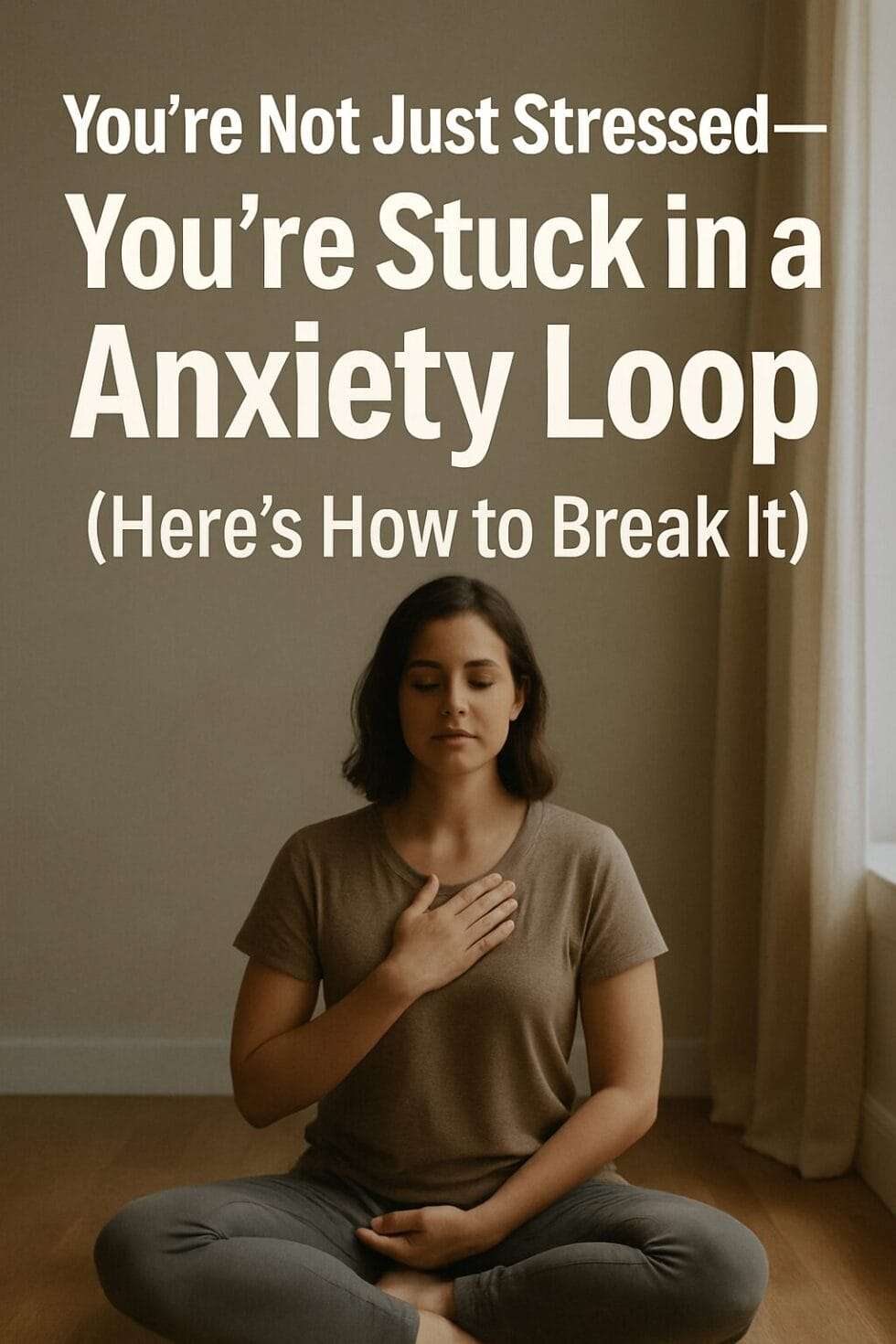
You’re Not Just Stressed—You’re Stuck in an Anxiety Loop (Here’s How to Break It)
- Author: Benjy Sherer
Whether you’re working on healing childhood trauma or you’re just a stressed out professional trying to maximize your productivity, healing anxiety is one of the most common symptoms that people tend to deal with. Far more importantly, however, the subconscious cycle that is at the root of anxiety is actually the very same feedback loop that is perpetuating things like stress, fear, self-doubt, Post-Traumatic Stress Disorder (PTSD), and so much more.
If you can understand and conquer this cycle, then you can free yourself from fear in all areas of your life and achieve a level of inner-peace and self-confidence that will allow you to see drastic improvements in all areas of your life.
Understanding the Three Elements of Anxiety
The first thing we need to understand is that anxiety is actually three separate things! People use the word ‘anxiety’ to describe a singular kind of experience, but it’s not actually quite so simple.
There are various elements to this experience which – if never understood and identified as separate – continue to manipulate each other in this an everlasting cycle that will keep you stuck for years… or even decades.

So, let’s take a look at the 3 distinct elements of anxiety:
- Cycling thoughts: A constant internal calculus of all the things that can go wrong and trying to figure out a way out of them—but of course, there’s never any end to this. Even if you do find a solution, you just start that mental calculus over again and try to justify it, but the calculus never works out the same way twice, so you just start over… and over… and over.
- An intangible sense of fear or dread that follows you around all the time, which leads to choice paralysis, indecision, inability to move or act, or do anything.
- The physical (or energetic) sensations that you feel in your body—i.e., the turning feeling in the pit of your stomach, the tightness in your chest, the lump in your throat, etc. (PS: Why I call them ‘energetic’ sensations is because you feel them physically, but they aren’t actually physical in the sense that you could physically observe them with, say, an MRI or X-ray).
What's really happening in that moment is that your brain is trying to make sense of that intangible feeling of fear that you're experiencing. And—because you're used to living up in your head with logic and rationality—your brain is desperately trying to translate that emotion into thoughts and logic that it can try to tackle rationally.
Benjy Sherer
Breaking Down the Elements of Anxiety
Now… Although you likely know all of that intuitively, you probably use the word “anxiety” mainly to refer to that third element: the physical sensations.
What we need to understand about these three elements is that they are actually separate experiences that really have nothing to do with each other.
In the same way that colors, shapes and numbers are of completely separate categories that have nothing to do with one another directly, so are thoughts, emotions and sensations of completely different forms. A thought is not an emotion any more than a sound is a smell. They are of a completely different nature.

But they do manipulate each other every moment of every day. Our thoughts impact our emotions and create stress responses in our bodies. Those stress responses keep us in a state of fear and create more thoughts.
And living in a state of fear keeps us thinking a certain way and keeps our body in that fight-or-flight mode. There is this ongoing cycle going on between those three elements, and unless we take control of it, it will continue in an endless feedback loop that keeps building up that energy, keeping us in a state of anxiety.
So, what we need to do is isolate those three elements and learn how to deal with each one individually while ensuring that they don’t keep bleeding onto each other.
Now that we understand this… we can start by dealing with our thoughts, because that’s where most of us spend most of our attention. We live up in our heads and run from the discomfort in our bodies and in our hearts. So, let’s tackle the thoughts first.
Step 1: Addressing Your Thoughts
The first step is to recognize that your cycling thoughts of rumination aren’t as real as you think they are. They are not, in fact, accurate reflections and calculations of the things you are worrying about. What’s really happening in that moment is that your brain is trying to make sense of that intangible feeling of fear that you’re experiencing.
And—because you’re used to living up in your head with logic and rationality—your brain is desperately trying to translate that emotion into thoughts and logic that it can try to tackle rationally. So, the thoughts aren’t real… they are merely translations of an emotion.

Furthermore, even though subconsciously you believe that worrying and fretting about this thing is an appropriate and helpful response to a threatening situation, it’s not. Some part of you thinks that you need to worry about it in order to solve it, but that only makes it worse.
Like trying to describe a color with numbers, your brain is trying to express your fear as a thought. Recognizing this obviously doesn’t immediately make the thoughts go away, nor does it end the fear.
But what it does do is give you at least a brief moment of separation. One moment where you can say to yourself, “Okay… I know these thoughts aren’t real, so let’s put them aside for a moment and move on to the next step.”
5-Step Process for Managing Negative Thoughts
Now, here is (in brief) the 5-step process that I use to handle cycling negative thoughts of fear:

Step 1: Observe
Start seeing the thoughts in your head as something that is happening, as opposed to something you are doing. Your mind is not a computer that’s constantly calculating precise and objective reflections of your world. It’s more like a radio that’s constantly turning the frequency of your emotions into thoughts.
They are not as real as we think they are—they are always being manipulated by our emotions. This is not to say that logic and rationality have no value, but rather to understand that our thoughts are, to a great extent, beyond our control and always under the influence of our emotions. So, we practice noticing and observing them. They’re just there, especially the negative thoughts. They are not real and accurate representations of our reality.
Step 2: Recognize
When you catch yourself in any negative thought cycle (including ruminating over your problems, judgment of others or yourself, overthinking, and over-analysis…), congratulate yourself for catching it. This is a very important piece of the puzzle. You are not failing by having negative thoughts. It’s just normal. And you are massively succeeding by catching them!
The key here is not just to give lip service to congratulating yourself, but to genuinely recognize the accomplishment of separating yourself from your thoughts for a moment and catching yourself in this cycle. This way, we create a positive emotional reaction to our negative thought cycles. We “give our brain a cookie” and provide positive reinforcement, training ourselves to want to catch our thought cycles more and more often.
The more healing you do, the more those moments of relief become common, and eventually, anxiety becomes the occasional glimpse—until it disappears altogether.
Benjy Sherer
Step 3: Appreciate
Thank the thoughts for trying to keep you safe. We want to make sure we are not making enemies with the wounded parts of ourselves that are expressing themselves through those thoughts. We need to recognize that our minds are, in fact, doing this to try to keep us safe. It’s foolish… it’s making a mistake… but it’s trying. It loves us. It’s like a dog that constantly barks at everyone who approaches you, even though those people are your friends. The dog loves you… but it’s causing problems. So, we want to adjust the behavior, but we don’t want to “punish” it.
Our goal here is to stop that emotion from leading us back into negative thought cycles. Understand that the fear you’re feeling isn’t a sign of danger, and that there’s nothing you need to do to end it.
Benjy Sherer
Step 4: Release
Tell the thoughts they’ve done their job and they can go home now. Again, this is important because there’s a big difference between yelling at our thoughts, saying, “No! Bad job! Stop thinking that!” versus saying, “All right, thanks for expressing yourself, but I’m safe now and you can go.” It’s a very different emotional response. The first reinforces the idea that we’re in danger… that the negative thoughts themselves are a threat. The second reinforces the idea that you’re safe. Big difference.
Step 5: Substitute
Replace the negative thought with a positive alternative three times to start paving the opposite pathway.
I know that sounds like a lot, but it will become second nature pretty quickly and can all be done in two seconds once you get used to it. Plus, this is just a preliminary step of a larger process where we’re going to quickly move past our thoughts and into the emotions that are underneath them.
The image below summarizes these steps. Next, we will discuss processing the emotional fear or dread.

Step 2: Processing the Emotional Fear or Dread
Great, now let’s move on to Step #2: the emotion—specifically, that intangible sense of fear and dread.
The first thing we need to recognize is that emotions are always changing, and they will pass. One of the worst things about fear (or any negative emotion) is that it can convince us that hard times are here to stay. It makes us believe the situation causing it is real and permanent, that we’re doomed to suffer until the source of our fear goes away—if it ever does.

The Nature of Emotions
But that’s never the case. Even when you’ve struggled with anxiety or depression for years, there are usually brief moments of relief, proving that emotions are always changing. The more healing you do, the more those moments of relief become common, and eventually, anxiety becomes the occasional glimpse—until it disappears altogether.
Emotions are like passing storms; they’re always moving. In some “stormier” places, there may be more storms than dry days, but in other places, rain is rare. By doing inner work, your job is to move yourself to that “drier climate.”
The point here is to acknowledge that your emotion is a passing storm. The fact that you’re feeling it now isn’t a sign of any real danger; it’s just an uncomfortable emotional storm that will pass. Our goal here is to stop that emotion from leading us back into negative thought cycles. Understand that the fear you’re feeling isn’t a sign of danger, and that there’s nothing you need to do to end it.
In fact, the emotion you’re feeling is just your body processing something. So, the goal is to step aside, stop adding fuel to the fire, and let your body do what it needs to do. We’re not trying to push the emotion away or make it disappear; we’re simply letting it run its course, like a bad cold. Be kind and patient with yourself, and let it move through.
Again, bringing this awareness and calm perspective to the emotion gives you a moment of separation from it. You can realize that, even though you’re feeling something unpleasant, it will pass, and there’s nothing to worry about. This helps release some resistance, allowing you to move on to the next step.
Confronting Physical Sensations

Now, here’s where the real transformation begins. What’s left after all this is that twisting feeling in your stomach, that tightness in your chest, or wherever it manifests, right?
Usually, we run from that feeling. We see it as a sign of danger, as if it’s a signal from our body warning us of some lurking threat. It feels uncomfortable, so we avoid it. We do whatever we can to “survive” the moment, be it with distractions, medication, or meditation. Right?
So, here’s what I want you to do: focus on that feeling. Do not run from it! Direct your attention toward that twisting sensation, as if you had to describe it to a sketch artist—or better yet, an abstract painter who could capture it for you. Allow yourself to experience the physical sensation as precisely as possible, without translating it into thoughts or emotions. Focus right on it.
Feel it. Don’t think about it. Don’t analyze it.
Just feel it. Give it your undivided attention. Here’s what you’ll discover when you learn to do this: that twisting feeling in the pit of your stomach? That’s all it is! A stomach ache. And like all stomach aches, it will pass. Imagine if every time you got a regular stomach ache, you convinced yourself you had a serious illness and were on the verge of disaster. This would cause ongoing stress, anxiety, and fearful thoughts.
Your goal is to keep your body relaxed, avoid stepping into negative thoughts cycles, accept the emotion you’re in and focus directly on the discomfort while allowing yourself to fully cry, scream, shake, or laugh so that your body can transform this energy into a form of movement that is connected to your emotions.
Benjy Sherer
Understanding the Cycle
Now imagine if those stomach aches were caused by the stress and fearful thoughts themselves, leading to an endless loop where your stomach pain created anxious thoughts, which then created more pain, and on and on. Because that’s exactly what’s happening with your anxiety.
This is the subconscious cycle among the three elements I mentioned. Your brain translates uncomfortable emotions into thoughts, the thoughts signal danger to your subconscious, which manifests as a twisting feeling. That sensation then sparks more worry, more fearful thoughts, and the cycle continues.
But when you allow yourself to focus directly on the sensation without fear, recognizing that—although uncomfortable—it’s not a sign of danger, your body can start to relax.
Step 3: Addressing the Physical Sensations
Now, let’s actively help the body process those sensations. There are many tools and skills that can help us move that energy within us, but let’s stick with the simplest ones for now.

Transforming Emotional Energy into Motion
You have to understand that when we’re talking about ‘energy’ here, we mean that in a very literal sense. We’re not talking about some spiritual or esoteric notion of chi or prana or anything like that. We’re referring to literal, physical energy. The same way that the body takes calories from food and turns it into motion, we need to turn the energy that is underneath our emotions into motion as well.
If you eat a lot of pizza every night and never move your body, you will gain weight. Similarly, if you experience strong emotions regularly and don’t do anything to purge them, you will gain ‘emotional weight’. So, we need to allow our bodies to transform this emotional energy into some kind of movement in order to properly purge and process what’s happening.
Natural Ways to Release Emotional Energy
Fortunately, the body has several natural ways that it already knows how to do this. The most common are: Crying, screaming, shaking, and laughing. These are emotional actions that your body can take to transmute emotional energy into physical movement in a way that allows you to properly release these emotional calories that are building up in the moment.
Embracing Movement for Emotional Processing
So, at this point in the process, your goal is to keep your body relaxed, avoid stepping into negative thoughts cycles, accept the emotion you’re in and focus directly on the discomfort while allowing yourself to fully cry, scream, shake, or laugh so that your body can transform this energy into a form of movement that is connected to your emotions.
Each time we do this, it helps us release unresolved energy beneath them, strengthens our resilience to confront heavier triggers, and stops us from fearing the sensations. They stop fooling us into thinking something’s wrong, preventing that old feedback loop from reactivating. Instead, we simply acknowledge them without letting them control us.
Practicing and Reinforcing the Process
And if you continue releasing unresolved energy while building strong habits and emotional skills, you’ll enter an upward spiral toward true emotional health where you can genuinely enjoy life again.

Of course, all of this takes practice. None of these methods are meant to be a quick fix to instantly heal you from anxiety. They’re skills and mental muscles you build over time. Just as a martial artist takes time to perfect a kick, you’ll take time to master these techniques.
But the beauty is that each moment you practice these skills is better than the alternative: letting yourself spiral back into the old cycle. Each moment of practice might not relieve all discomfort, but it will make the moment a little better. We practice these techniques to suffer less now, and the stronger we become, the less likely we are to be triggered in the future.
If you’d like to learn more about this practical approach to healing anxiety, trauma, fear, and stress and dive into a guaranteed process to conquer these issues once and for all, please visit my website: https://benjysherercoaching.com

Benjy Sherer
Benjy Sherer is a mental health coach and emotional fitness trainer offering a pragmatic and guaranteed approach to conquering anxiety, stress and trauma. His approach involves bypassing the analysis of our traumatic memories, focusing instead on building the practical skills and tools necessary to turn moments of emotional distress into moments of healing and strengthening. Your body is constantly trying to help you heal. Benjy will show you how to let that happen.





